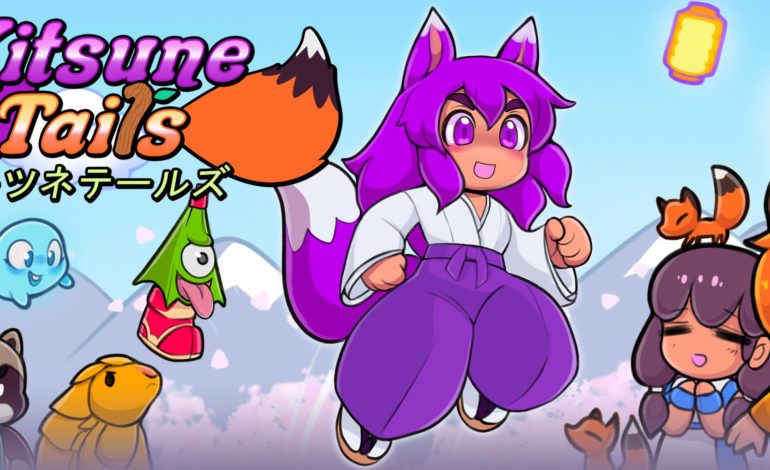

Kitsune Tails is a retro 2D-platformer inspired by Japanese mythology and the next title slated for release from Super Bernie World developers Kitsune Games. Immediately upon starting, Kitsune Tails reveals it’s main inspiration in gameplay and design: Super Mario Bros. 3. Kitsune Tails emulates the feeling of SMB3 on a near-identical level, with the same momentum and handling of controls and abilities as the 1988 Nintendo game. The problem here is that even though it’s been 34 years since Super Mario Bros. 3 has released, the team behind Kitsune Tails have made no improvements on its decades-old design. In fact, there were many points when playing the extended preview that I felt Kitsune Tails took steps backward from the classic NES platformer.
The game design in Kitsune Tails is repeatedly confusing and makes the experience even more difficult for anyone that has played traditional platformers. Universal mechanics like power-ups and level types are scrambled and changed for no reason other than the appearance of innovation. Water levels and non-water levels are presented seamlessly in the game, so a player can run on land then jump into water then start swimming. One of the issues with this is that not all of the bodies of water in the game allow the player to swim, so I had several moments where what I thought was a safe jump lead to instant death. Issues like this one plague the game, ranging from developer choices that seem completely unnecessary to others that feel deliberately heinous. Some other examples I ran into included:
- The fire-less “Super Yuzu” power-up being misleadingly shaped like a fireball
- The star power-up reverting you back to a smaller size for its duration
- Not telling the player that they can spend the coins they pick up at a “village” only accessible through the pause menu in the overworld
- An unnecessarily massive inventory uses the “B” button (universally recognized as the button to back out of a menu) to scrap the rare power-up that actually gets added to that inventory
- A complete lack of offensive power-ups for the first entire world of the game
Even when new ideas are brought into the game, their complexity overpowers the simple formula of the classic platformers of the NES era. Adding a dash to the star power-up destroys blocks and enemies, but with no way to see how long the power-up lasts (there’s no music change for the Kitsune Tails star), you can end up over a pit of spikes or millimeters away from an enemy once the invulnerability abruptly ends. Enemies that fly around the screen in super-fast attack animations overwhelm your simple jump-and-run moves. Power-ups that help you progress through levels (a samurai power-up lets you perch on your spear after it’s impaled into the wall) are a requirement, and if you lose that power when you get hit, you’ll be unable to progress through the level, forcing a restart or killing yourself. In one instance, I unlocked a tanooki-style suit with a digging mechanic similar to the one in Shovel Knight (attack downwards, destroy a dirt block, and bounce off). But, it’s impossible to stop this move until you land on solid ground. The level I was playing was filled with dirt blocks and enemies, so I was left waiting for the attack to end and praying I wouldn’t land in a bad spot. Issues like this are constant, making each new ability feel less like a powerful upgrade and more like a shift to a different, but equally annoying, game altogether.
Kitsune Tails’ saving grace is its charming LGBT+ story, following a cute kitsune named Yuzu as she falls for a human healer named Aiko. Dialogue is brief and generic, but charming nonetheless. As a love triangle begins to form between the two lovers and Yuzu’s former mentor, Kiri, cutscenes featuring the charming sprites of this trio of girls make the love story even cuter. But, of course, disaster strikes, and in a familiar twist, Aiko is kidnapped and trapped inside a far away castle. From what I saw, the plot comes screeching to a halt at this point, and the player is left to experience Yuzu’s long journey through the kingdom, with far less developments in story or plot. I was able to play the first two worlds of what seemed to be 5 or 6 total, and in world 2 I saw extremely minimal dialogue and cutscenes. Hopefully, later worlds in the game return to featuring more story elements, but even then, it wouldn’t be worth the game’s frustrating design.
Kitsune Tails sets out to create a new game with a bit of heart for Super Mario Bros. fans, and in many ways accomplishes its goal. But even though the game controls and looks like the NES classics, it doesn’t manage to recognize their polished design and simplicity.
Play games, take surveys and take advantage of special offers to help support mxdwn. Every dollar helps keep the content you love coming every single day.
